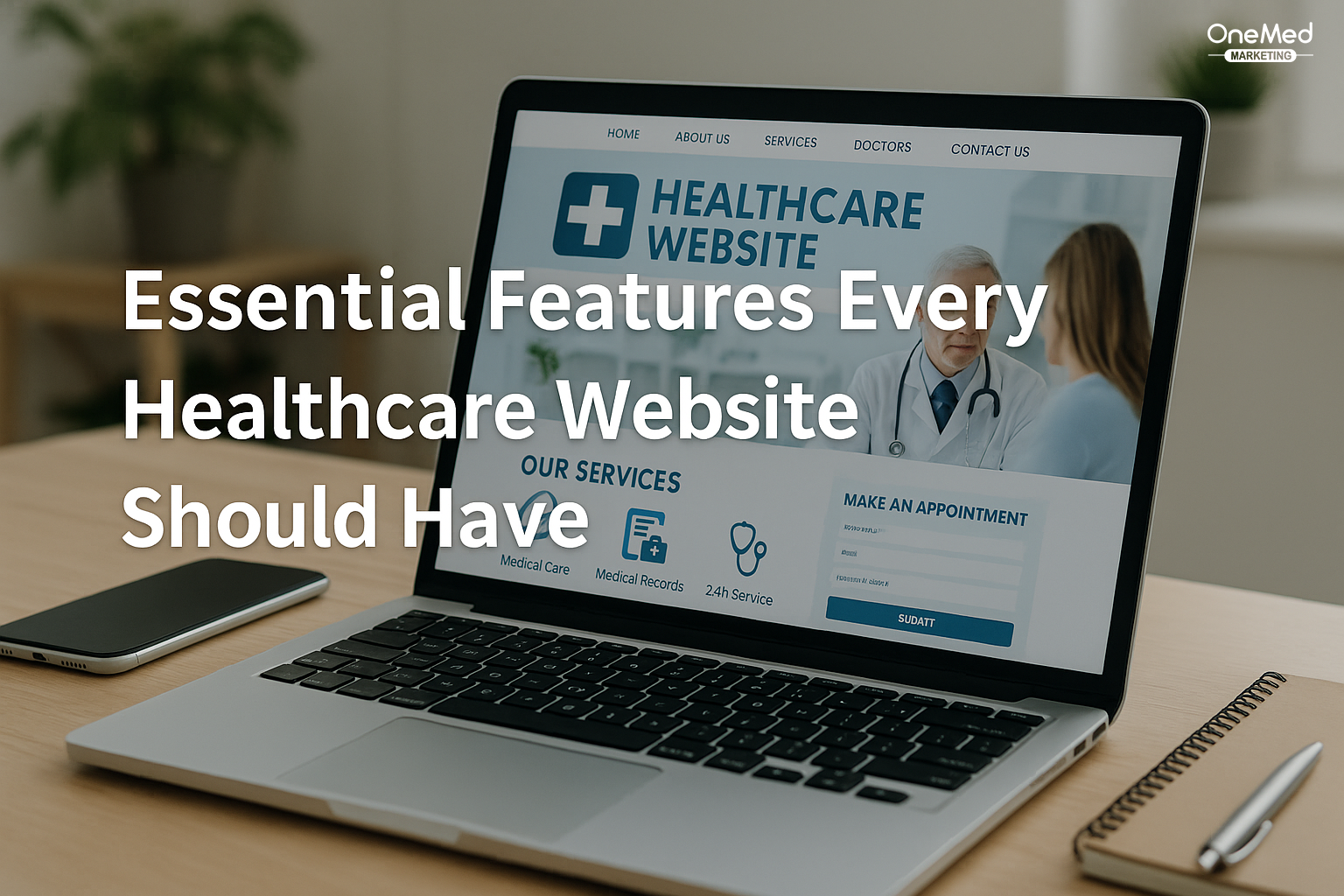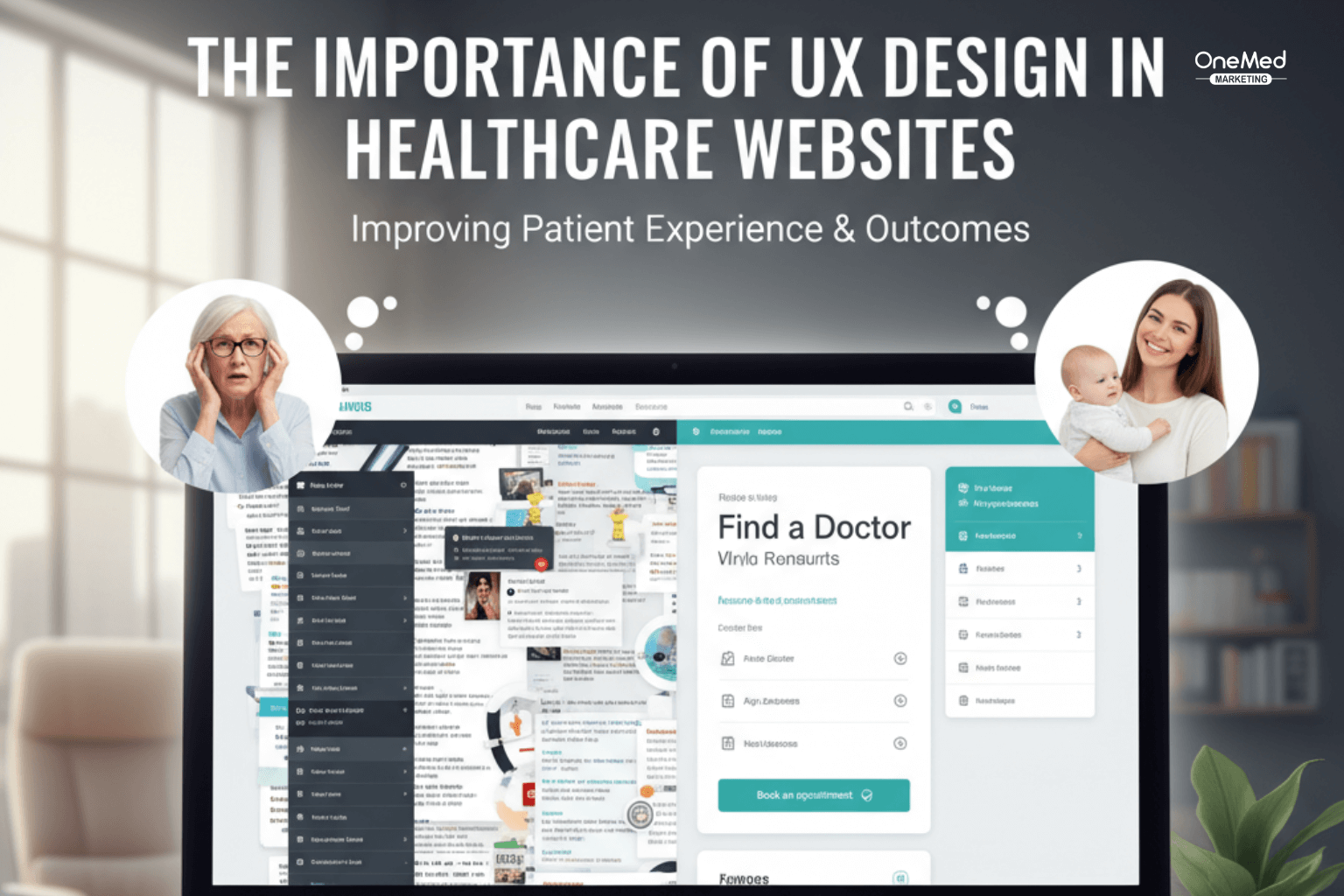- info@onemedmarketing.com
- 4th Floor, Nemours Building, 1007 North Orange St. , Wilmington, DE 19801, United States

Essential Features Every Healthcare Website Should Have
A website is often the first impression a patient has of a healthcare provider. Before booking an appointment, patients search online to check services, office hours, reviews, and even billing options. If the website is confusing, slow, or missing information, many patients will simply move on to another practice.
A strong healthcare website does more than provide basic details. It builds trust, guides patients to the right information, and makes it easy for them to take action. Below are the essential features every healthcare website should include to support both patients and providers.
In this blog, we will cover the following topics:
- Why Healthcare Websites Matter
- Easy Navigation and Mobile-Friendly Design
- Fast, Secure, and Accessible Performance
- Online Appointment Scheduling and Patient Portals
- Provider Profiles, Services, and Patient Resources
- Reviews, Testimonials, and Contact Details
- Conclusion
- Frequently Asked Questions
Why Healthcare Websites Matter
Patients expect convenience. When they search for a doctor, they want answers within seconds. A healthcare website acts as the digital front door of a practice. A clean, modern site signals professionalism, while an outdated or cluttered site raises doubts.
Patients use websites to confirm if a provider offers the care they need, check if insurance is accepted, and decide whether to trust the practice. This means your website is not just a marketing tool—it is part of the patient experience.
Easy Navigation and Mobile-Friendly Design
Simple navigation that guides patients
Patients should never have to guess where to click. Menus should be short, clear, and focused on what patients look for most: services, providers, appointments, and contact details.
Designed for mobile users
Most patients search on their phones, not desktops. A mobile-friendly website adapts to smaller screens, loads quickly, and uses features like click-to-call buttons and maps. Without this, patients may leave before they even explore the site.
Fast, Secure, and Accessible Performance
Speed matters
Slow websites frustrate patients. Research shows users often leave if a page takes more than a few seconds to load. A fast site helps patients stay engaged and also ranks better on Google.
Security builds trust
Healthcare websites must protect sensitive information. Using SSL certificates, secure hosting, and HIPAA-compliant tools shows patients that privacy is taken seriously.
Accessibility for all patients
Every patient should be able to use your site, including those with disabilities. Features like alt text for images, captions for videos, and color contrast make content more inclusive and ADA-compliant.
Online Appointment Scheduling and Patient Portals
Easy booking options
Patients want the ability to book appointments online instead of calling during office hours. A simple scheduling tool saves time for patients and staff while reducing no-shows.
Patient portal access
Modern patients expect more than just scheduling. Portals that allow them to view test results, pay bills, and message providers improve engagement and reduce calls to the office.
Provider Profiles, Services, and Patient Resources
Building trust through provider profiles
Patients want to know who will treat them. Adding photos, short bios, and qualifications helps patients feel comfortable choosing a provider.
Clear explanations of services
Service pages should explain treatments in plain language. Instead of heavy medical terms, use simple descriptions so patients understand what care is available.
Educational resources for patients
Blogs, FAQs, and guides answer common questions and build credibility. Adding visuals like infographics or short videos makes information easier to understand and remember.
Reviews, Testimonials, and Contact Details
Reviews that influence patient decisions
Reviews are one of the first things patients check before booking. Featuring testimonials on your website builds trust and gives new patients confidence.
Contact details that are easy to find
Phone numbers, addresses, and email options should be visible on every page. Adding a map and directions reduces confusion for new patients, and click-to-call features make reaching your office simple.
Conclusion
A healthcare website is more than a digital brochure—it is an essential part of patient care. Patients rely on websites to decide where to go for treatment, and they expect speed, security, and convenience.
By focusing on clear navigation, mobile-friendly design, fast performance, online scheduling, provider profiles, patient education, and trust-building features like reviews, healthcare practices can create websites that truly support their patients.
A well-designed site improves more than first impressions. It helps patients take action, strengthens trust in the provider, and makes the entire care journey smoother. For practices, investing in a patient-friendly website is investing in better relationships, stronger engagement, and long-term success.
Frequently Asked Questions
1. Why is a healthcare website so important for patients?
A healthcare website is often the first place patients look before booking care. It helps them check services, office hours, providers, and reviews. A good website builds trust and makes it easy for patients to take the next step.
2. What features make a healthcare website patient-friendly?
Important features include simple navigation, mobile-friendly design, fast performance, secure hosting, online appointment scheduling, provider profiles, and clear contact information.
3. How does online appointment scheduling benefit patients and providers?
Online scheduling saves time for patients, reduces phone calls, and lets them book at their convenience. For providers, it helps fill appointment slots faster and lowers the risk of missed visits.
4. Why are reviews and testimonials important on healthcare websites?
Reviews give new patients confidence by showing real experiences from others. Testimonials on a website help build trust and encourage more patients to choose your practice.







0 Comments
Leave a Comment